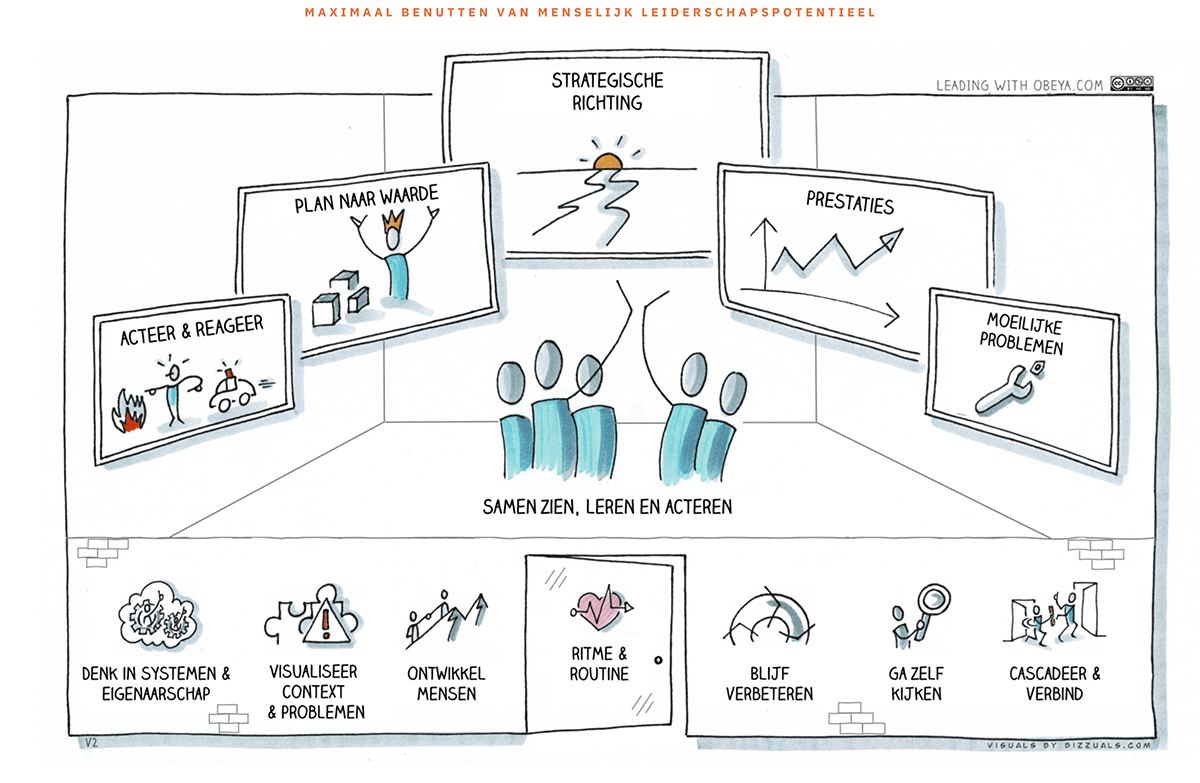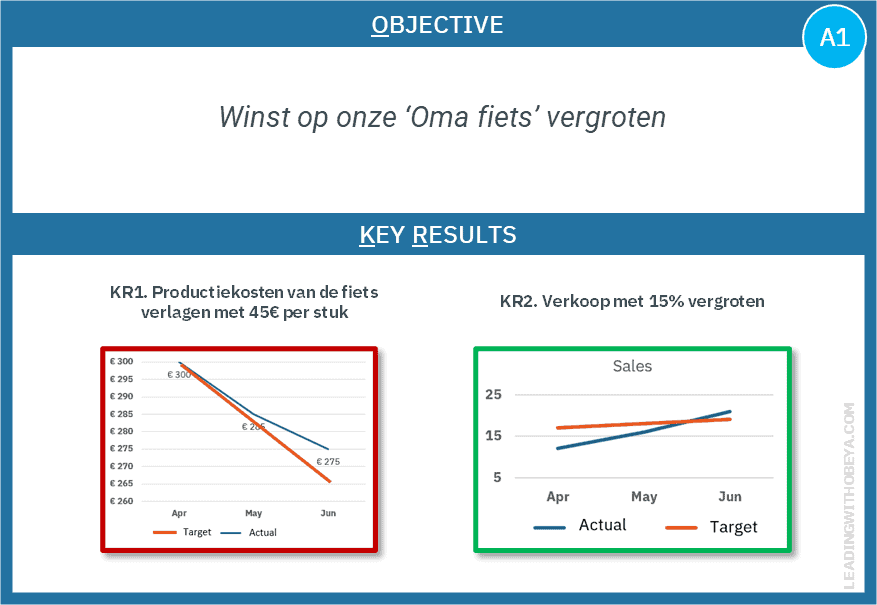
Obeya en OKR’s gaan hand in hand en kan elkaar enorm versterken. Met de Leading with Obeya methode stuur je aan op ontwikkelingen en blijvend succes van je organisatie. Met OKR’s breng je hierin nog meer focus en prioriteiten aan. In dit artikel zoomen we in op wat OKR’s en Obeya precies zijn, waar het vaak misgaat bij OKR’s én hoe je deze methodes effectief kunt combineren.
Obeya and OKRs go hand in hand and can really reinforce each other. With the Leading with Obeya method, you can drive development and the continued success of your organization. OKRs allow you to add even more focus and priority. In this article, we zoom in on exactly what OKRs and Obeya are, we explain where OKRs often go wrong, and give you tips on how to effectively combine these methods.
What are OKRs and where did they originate from?
OKRs (short for Objective and Key Results) are based on Peter Drucker’s philosophy. He was a well-known management guru in the 20th century and a promoter of Management by Objectives (MBO). According to Peter, a professional who has a goal (objective) will do everything in their power to achieve it. Sounds good, right? However, in practice, things often work out differently. People have a tendency to become so focused on goals and targets that they stop working towards the bigger picture, or even try to achieve their goals, to the detriment of other parts or people in the organization. Not because they are bad people, but because the reward center in our brain affects much of our behavior, either consciously or unconsciously. In this way, achieving goals can become a dominant force.
Therefore, James Edwards Deming – another well-known management guru who became famous for his Lean method – did not entirely agree with Drucker’s approach. Although he liked the basic idea, he said that people were applying it the wrong way. According to him, you shouldn’t send individuals into the world armed with their own goals, but rather direct them to work together and improve the organization as a whole. In other words, he felt that people need to agree on goals at the organizational level. In addition, Deming emphasized the process of improvement itself rather than the goal. The idea was to achieve your goal not only this year, but to make you better able to do so again next year. Only then can people achieve sustainably improved results that actually serve the organization.
Former Intel CEO Andrew Grove expanded on Drucker’s idea in 1995, with more focus on collaborative rather than individual results. And it appeared to work quite well. John Doerr (of Google fame) also took this idea on board. He managed to successfully apply it within Google, laying the foundation for what we know today as Objectives and Key Results (OKR).
According to Google, OKRs are important for alignment and focus over a period of time. They recommend agreeing on 3 OKRs per team only. There must be a qualitative goal (Objective) with measurable results (Key Results). People need to consider what is required to achieve the goal. To that end, milestones must be determined: planned milestones that positively affect OKRs throughout the process.
OKR A real-life OKR example
Let’s take a concrete example: an OKR might look something like this in practice.
Objective = In the coming quarter we want to sell more granny bikes to maintain product profitability.
Key Result = Sell 15% more granny bikes compared to last quarter
Milestones:
• Giving the granny bike a trendy color;
• Launching a campaign, building a landing page;
• Optimizing the website for conversions for the granny bike;
• Launching a campaign.
Now we think that – if we reach the milestones – we will achieve the ultimate goal of 15% more sales. In other words, the milestones are hypotheses that we expect to need in order to achieve the goal.
Common OKR mistakes, and how Obeya helps with them
Lots of organizations apply OKRs. Bear in mind, however, that when you copy something, what works well in one organization will not necessarily work for you. Moreover, unless you have a good understanding of what you are copying, you will not be able to apply it effectively. In my work as a trainer and coach, I come across three common mistakes that people make when pursuing OKRs. I want to share them with you, and explain how the Leading with Obeya (LWO) method helps with this:
1. Teams come up with too many OKRs
If the management is not properly focused and decides to choose 10 OKRs, the management level below it will probably come up with 10 OKRs as well. And the team below that again will generate 10 OKRs. Google suggests that you should have a maximum of three per team, otherwise it leads to lack of focus, and priorities in the organization actually risk becoming diffuse. This is the opposite of what we want to achieve.
In the Obeya, there is limited space for OKRs, and by visualizing them, we can also see when there are too many of them. In this way, the team in the Obeya is always aware of how many OKRs they have come up with and what they focus on.
2. OKRs are not cascaded throughout the organization
So, if the management has OKRs that the shop floor should implement, but the shop floor has not adopted those OKRs, then the focus on the shop floor is still elsewhere. In other words, all levels of the organization must be aligned in order to implement OKRs.
Because the Obeya is accessible to everyone in the organization, it is very easy to visit the rooms of different teams to see how they have aligned their OKRs with the rest of the organization.
3. OKRs are conceived spontaneously
We work with what springs to mind first. So, when we start coming up with OKRs, sometimes they’re primarily determined by what happened in the company earlier that week, or by a specific email you opened this morning. The problem here is that we cannot oversee the performance of our organization and consequently are unable to see where the focus should really be in that moment. Focus without context tends toward tunnel vision: you ignore (unconsciously) other important issues that might be at play that you need to pay attention to.
That is why in the Obeya, we ensure that the performance of the entire system is visible. So, when we apply focus, we can also oversee where the main problems or challenges lie and thus where we want to make the most impact. On that basis, we choose quarterly which OKRs are really the most valuable at that time to pursue.
What is Leading with Obeya?
Obeya (Japanese for “big room”) was applied successfully at Toyota in the 90s to develop the Prius. Obeya proved very effective for Toyota: the Prius was developed at record-breaking speed and became the most successful hybrid car worldwide. The Obeya is primarily about visual management in a large room; it helps people solve problems and make improvements in a team or organization.
Although more and more organizations are starting to recognize the usefulness of Obeya, it is important to have a clear understanding of what it is, and how to use it properly. Otherwise, you risk merely copying part of a method and hope for the best, while you will likely fail to achieve actual success.
My book, Leadership with Obeya, explains how to use Obeya: not to develop a Prius but in order to successfully lead your team or organization. The book explains how you can create, bring to life, and implement a strategic plan in practice. It is so practice-oriented that you can start using it tomorrow if you wish.
Below you can find a reference model with an overview of the Leading with Obeya (LWO) method. You can also download it here.

It consists of two parts, and the team is central. At the top, you see the boards you can expect to see in an Obeya for leading teams and organizations. The bottom part is all about the principles that should be applied in your team’s thinking and actions.
So, how do we combine OKRs with Leading with Obeya?
There are a few very important components here:
1. A strategic direction
If you set a clear direction with continuous, strategic goals, you can aim to achieve it together. It is about everything that is crucial to the team’s success. The idea is to put it into words, in broad strokes. The Objectives in the OKRs should be in line with this. Last but not least: if an Objective does not match this, why would we do it?
2. Performance
The strategic direction has clarified what matters to achieve team success. The next step is to keep an eye on how you are performing as a team. You can do this by making measurable or discernable accomplishments visible and always comparing them to the goal or goals. Is everything going according to plan, or will adjustments need to be made? This is where we can see Key Results reflected, in the form of indicators. Some of these indicators should always be monitored, e.g., customer satisfaction. In addition, the team picks one specific focus each quarter by defining OKRs, e.g., to increase Time to Market in various parts of the organization. In this way, the team uses an OKR to focus on this particular issue and the rest of the organization knows that specific steps need to be taken to that end.
3. Tough Problems
OKRs are often ambitious. You don’t know beforehand exactly what you need to do in order to achieve the Key Results. In other words, you are faced with a tough problem. Keep this problem in sight and try to solve it. Tackle the issue in a structured and methodical way. Small but practical steps will help you structurally improve performance. As you progress, you will find out what obstacles there are and solve them step by step. Slowly but surely, you will see the Key Results improve.
4. Plan to value
If it is clear almost straight away what needs to be done to achieve an OKR, simply schedule the outcomes that need to be accomplished to do so. Once these results (milestones) are delivered (e.g., getting a landing page to go live), value is added to the achievement of the ultimate (strategic) goals. When delivering the milestones that we discussed earlier, we would also expect indicators or Key Results to be positively affected.
A milestone card should state what needs to be delivered, why we want to deliver it, and which indicator it will affect. In this way, every OKR can be translated into concrete and plannable tasks for the entire team.
Useful: OKR template for the Obeya: make it visual
So, what have we discussed? We talked about how the Obeya is, in fact, the strategic plan and that OKRs help to add focus within that plan. And that is precisely why it is so useful to combine them in a visual way. In the template below, you can see how this could be done.

Put up this template under Performance on the Obeya board, by the Strategic capability you want to affect. If you are clear on what needs to be delivered, place a milestone under Plan to Value. If the challenge of the OKR is so massive that you have no idea as yet what you should do positively affect the Key Results, you’re probably better off doing structured work under Tough Problems.
OKRs like the one in the example above are reviewed and reestablished quarterly. In between reviews, an OKR’s progress is always monitored and discussed during the biweekly performance session. This process helps you keep your focus and attention on the work within the Obeya and not lose sight of anything.
Conclusion
We can conclude that Obeya and OKRs go hand in hand and can greatly enhance each other. With the Leading with Obeya method, you can drive developments and the continued success of your organization. OKRs allow you to add even more focus and priority.
That is why we can safely state that OKRs are a very useful tool within the Obeya, especially when it comes to setting priorities. And you probably know that this is often much needed. The main problem that management teams tell us they often run into (in our Leadership Systems Scan), ) is that there are no clear priorities in place.
You have now gained insight into what OKRs are and how to use them within Obeya to start prioritizing. I am sure that they will help you and your team. If you have any questions, or if you are interested in getting started with the Leading With Obeya method, we cordially invite you to attend one of our training courses or e-learnings!


